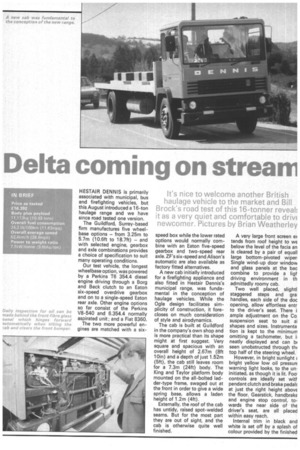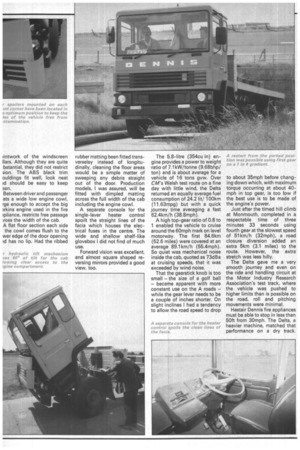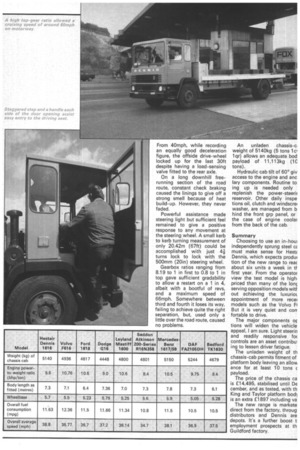Delta coming on stream'
Page 62

Page 63

Page 64

If you've noticed an error in this article please click here to report it so we can fix it.
It's nice to welcome another British haulage vehicle to the market and Bill Brock's road test of this 16-tonner reveal: it as a very quiet and comfortable to drivc newcomer. Pictures by Brian Weatherley
HESTAIR DENNIS is primarily associated with municipal, bus and firefighting vehicles, but this August introduced a 16-ton haulage range and we have since road tested one version.
The Guildford, Surrey-based firm manufactures five wheelbase options — from 3.25m to 5.7m (10.6ft to 18.7ft) — and with selected engine, gearbox and axle combinations provides a choice of specification to suit many operating conditions.
Our test vehicle, the longest wheelbase option, was powered by a Perkins T6 354.4 diesel engine driving through a Borg and Beck clutch to an Eaton six-speed overdrive gearbox and on to a single-speed Eaton rear axle. Other engine options so far consist of the Perkins V8-540 and 6.354.4 normally aspirated unit; and a Fiat 8360.
The two more powerful engines are matched with a six
speed box while the lower rated options would normally combine with an Eaton five-speed gearbox and two-speed rear axle. ZF's six-speed and Alison's automatic are also available as factory fitted alternatives.
A new cab initially introduced for a firefighting appliance and also fitted in Hestair Dennis's municipal range, was fundamental in the conception of haulage vehicles. While the Ogle design facilitates simplicity of construction, it forecloses on much consideration of style and airodynamics.
The cab is built at Guildford in the company's own shop and is more practical than its shape might at first suggest. Very square and spacious with an overall height of 2.67m (8ft 10in) and a depth of just 1.52m (5ft), the cab still leaves room for a 7.3m (24ft) body. The King and Taylor platform body mounted on the all-bolted ladder-type frame, swaged out at the front in order to give a wide spring base, allows a laden height of 1.2m (4ft).
Externally, the roof of the cab has untidy, raised spot-welded seams. But for the most part they are out of sight, and the cab is otherwise quite well finished.
A very large front screen e) tends from roof height to we below the level of the facia an is cleared by a pair of equall large bottom-pivoted wiper: Single wind-up door window and glass panels at the bac combine to provide a ligf. driving environment in th admittedly roomy cab.
Two well placed, slightl staggered steps and gral handles, each side of the doc opening, allow effortless entr to the driver's seat. There i ample adjustment on the Co. suspension seat to suit al shapes and sizes. lnstrumenta tion is kept to the minimum omitting a tachometer, but i: neatly displayed and can 13( seen unobstructed through thi top half of the steering wheel.
However, in bright sunlight bright yellow low oil pressur( warning light looks, to the uninitiated, as though it is lit. Fool controls are ideally set witl.
pendant clutch and brake pedalE at just the right height above the floor. Gearstick, handbrake and engine stop control, towards the near side of the driver's seat, are all placed within easy reach.
Internal trim in black and white is set off by a splash of colour provided by the finished iintwork of the windscreen liars. Although they are quite bstantial, they did not restrict ion. The ABS black trim ouldings fit well, look neat id should be easy to keep an.
Between Between driver and passenger ats a wide law engine cowl, rge enough to accept the big .rkins engine used in the fire )pliance, restricts free passage :ross the width of the cab.
A flat floor section each side the cowl comes flush to the wer edge of the door opening id has no lip. Had the ribbed rubber matting been fitted transverseley instead of longitudinally, cleaning the floor areas would be a simple matter of sweeping any debris straight out of the door. Production models, I was assured, will be fitted with dimpled matting across the full width of the cab including the engine cowl.
A separate console for the single-lever heater control spoilt the straight lines of the facia which houses the electrical fuses in the centre. The wide and shallow shelf-like glovebox I did not find of much use.
Forward vision was excellent, and almost square shaped reversing mirrors provided a good view, too. The 5.8-litre (354cu in) engine provides a power to weight ratio of 7.1kWitonne (9.68bhp/ ton) and is about average for a vehicle of 16 tons gvw. Over CM's Welsh test route on a fine day with little wind, the Delta returned an equally average fuel consumption of 24.2 lit/ 100km (11.63mpg) but with a quick journey time averaging a fast 62.4km/h (38.8mph).
A high top-gear ratio of 0.8 to 1 enabled the vehicle to cruise around the 60mph mark on level motorway. The first 84.6km (52.6 miles) were covered at an average 89.1km/h (55.4mph). So quiet was mechanical noise inside the cab, quoted as 73d Ba at cruising speeds, that it was exceeded by wind noise.
That the gearstick knob is too small — the size of a golf ball — became apparent with more constant use on the A roads — while the gear lever needs to be a couple of inches shorter. On slight inclines I had a tendency to allow the road speed to drop to about 35mph before changing down which, with maximum torque occurring at about 40mph in top gear, is too low if the best use is to be made of the engine's power.
Just after the timed hill climb at Monmouth, completed in a respectable time of three minutes 33 seconds using fourth gear at the slowest speed of 51km/h (32mph), a road closure diversion added an extra 5km (3.1 miles) to the route. However, the extra stretch was less hilly.
The Delta gave me a very smooth journey and even on the ride and handling circuit at the Motor Industry Research Association's test track, where the vehicle was pushed to higher limits than is possible on the road, roll and pitching movements were minimal.
Hestair Dennis fire appliances must be able to stop in less than 50ft from 30mph. The Delta, a heavier machine, matched that performance on a dry track. From 40mph, while recording an equally good deceleration figure, the offside drive-wheel locked up for the last 30ft despite having a load-sensing valve fitted to the rear axle.
On a long downhill freerunning section of the road route, constant check braking caused the linings to give off a strong smell because of heat build-up. However, they never faded.
Powerful assistance made steering light but sufficient feel remained to give a positive response to any movement at the steering wheel. A small kerb to kerb turning measurement of only 20.42m (67ft) could be accomplished with just 4:4 turns lock to lock with the 500mm (20in) steering wheel.
Gearbox ratios ranging from 8.19 to 1 in first to 0.8 to 1 in top gave sufficient gradability to allow a restart on a 1 in 4, albeit with a bootful of revs, and a maximum speed of 66mph. Somewhere between third and fourth it loses its way, failing to achieve quite the right separation, but, used only a little over the road route, caused no problems. An unladen chassis-c.
weight of 5140kg (5 tons lc) 1qr) allows an adequate bod payload of 11,113kg (1C tons).
Hydraulic cab tilt of 60° giv access to the engine and anc lary components. Routine to ing up is needed only replenish the power-steeril reservoir. Other daily inspe tions oil, clutch and windscrei washer, are managed from b hind the front grp panel, or the case of engine coolar from the back of the cab.
Summary Choosing to use an in-hory independently sprung steel cE must make sense for Hest Dennis, which expects produi tion of the new range to rear about six units a week in tf first year. From the operator view the test model is high priced than many of the lonc serving opposition models witf out achieving the luxuriot appointment of more recei models such as the Volvo Fr But it is very quiet and Gorr fortable to drive.
The major components or tions will widen the vehicle appeal, I am sure. Light steerin and readily responsive foc controls are an asset contribu' ing to lessen driver fatigue.
The unladen weight of th chassis-cab permits fitment of platform body leaving an allo\n, ance for at least 10 tons c payload.
The price of the chassis ca is £14,495, stabilised until De cember, and as tested, with th King and Taylor platform bod) is an extra £1897 including va The new range is markete direct from the factory, throug distributors and Dennis are depots. It's a further boost t employment prospects at th Guildford factory.




























































































































































































































































































